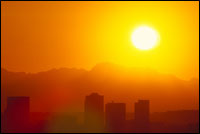Dear Umbra,
Our radio station provides daily information regarding ultraviolet ratings. I am curious about what these ratings actually represent, and why they change so dramatically. For example, for the past few years, most ratings have been between three and seven. Now we are getting ratings of 10. I doubt the ratings are directly related to Dobson units, which measure the amount of atmospheric ozone present, because they seem to change from day to day (and do not seem particularly related to cloud cover — or do Dobson units change that frequently?). Any clarification would be welcomed.
Jack
Hamilton, Ontario, Canada

How wary should you be of those rays?
Dearest Jack,
Let’s all go on another journey through Umbra’s World of Science. Too bad you can’t see the hand puppets.
Ozone is a molecule made of three oxygen atoms. It’s toxic to us living beings in concentrated amounts, but in small quantities, drifting far above the earth, it is our friend. It blocks the sun’s ultraviolet rays and saves us from severe erythema, aka red skin. The presence of ozone in our troposphere and stratosphere is measured in Dobson units, which are very science-y. Imagine an extremely tall, skinny French press reaching high up into the outermost reaches of the stratosphere. Then imagine pressing the plunger and pushing all the ozone molecules down to the bottom of the press as you would your coffee grounds. Dobson units measure the depth of the ozone molecules in this theoretical situation, assuming standard temperature and pressure conditions inside the French press.
The ultraviolet index uses ozone measurements from souped-up French presses worldwide to help forecast ozone levels in specific locations. But while Dobson units do play a role in the UV index, the numbers are far from directly correlated. The actual calculations used to arrive at ultraviolet forecasts involve a variety of other factors as well, including location, elevation, date, time, predicted cloud cover, and complex equations. Eventually, the friendly scientists take pity on us poor ignoramuses and do some simple division and rounding to end up with an easily recognizable number such as “10.” (The U.S. EPA gives a thorough description of how these numbers are arrived at, if you wish to know more.)
The conveniently rounded-off number falls on a scale from zero to — well, you might see a rating of 16 or even higher if you live close to the equator. The higher the number, the greater the hazard to living things. When your radio announces a UV rating of 8 or higher, you might want to stay indoors or perambulate al fresco in maximum swathing (and even ratings of 3 to 5 indicate a moderate risk — check out the EPA’s UVA Index Scale page for the full story). I probably don’t need to tell you all the results of UV overexposure: cancer, prematurely aging skin, cataracts, etc.
As for why the numbers change over time: Factors such as elevation and latitude stay constant, of course. The change in UV ratings, then, reflects changing ozone concentration, time of year, and yes, cloud cover. The increasing numbers you’ve seen in the last few years must reflect steady changes in your area in one (or more) of these factors. The obvious human-controlled variable in the batch is ozone concentration. Gaseous aftereffects of CFCs, HCFCs, methyl bromide, and other icky substances thin the ozone layer and allow UV rays through in higher amounts.
That’s not good, and not enough has been done to solve the problem or future problems which may arise. Luckily, even governments that are unwilling to address environmental problems at the root are willing to pay to maintain such items as the air-quality index, the stream-pollution listing, and the UV index. The upshot: At least you know how much your planned jog followed by a plunge into a sun-dappled stream is going to hurt you.
Erythemally,
Umbra


